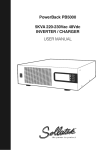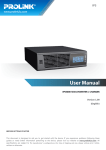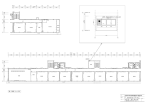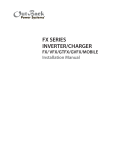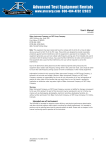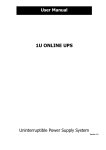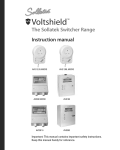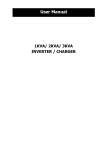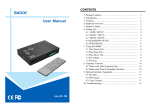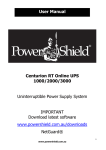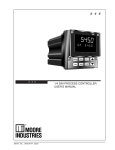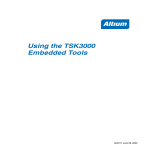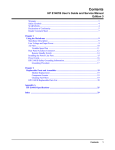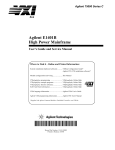Download PowerBack PB3000 3KVA 220-230Vac 24Vdc INVERTER
Transcript
PowerBack PB3000 3KVA 220-230Vac 24Vdc INVERTER / CHARGER USER MANUAL the power to protect Contents PURPOSE IMPORTANT SAFETY INSTRUCTIONS General Precautions Personal Precautions DESCRIPTION OF OPERATION Operational Data Priority Loads INSTALLATION Unpacking and Inspection Basic Configuration Positioning of PowerBack and battery system Batteries Battery Cable Size DC Disconnect and Over-Current Protection Battery Cable Connection AC Cable Size AC Connections AC Isolation and Overcurrent Protection AC Loads Protecting your PowerBack Commissioning of PowerBack OPERATION Front Panel Controls and LCD Indicators Power ON/OFF Configuration Switch LCD Indicator and Alarm Battery Charger Operating Indicators Setting Indicators Internal Circuit Breaker Workshop Serviceable Items SPECIFICATIONS Line Mode Specifications Inverter Mode Specifications Charge Mode Specifications Approximate back-up time General Specifications Fault code/ Audible alarm TROUBLESHOOTING SERVICING OF POWERBACK Guarantee Returns Warranty 2 S o l l a t e k P o w e r B a c k M A N U AL 3 3 3 4 4 5 5 5 5 5 8 8 8 9 9 10 11 12 12 12 12 13 13 13 14 15 15 16 17 18 18 19 19 20 21 22 22 23 23 24 25 25 26 PURPOSE This manual explains procedures for the unit’s installation, operation and troubleshooting Please take time to understand the contents of this manual prior to installation and operation. IMPORTANT SAFETY INSTRUCTIONS WARNING: This chapter contains important safety and operating instructions. Read and keep this User Guide for future reference. Display this notice at location of batteries. General Precautions 1. Before using the unit, read all instructions and cautionary markings on: The unit (2) the batteries (3) all appropriate sections of this manual. 2. CAUTION -To reduce risk of injury, charge only deep-cycle lead acid type rechargeable batteries. Other types of batteries may burst, causing personal injury and damage. 3. Do not expose the unit to rain, snow or liquids of any type. The unit is designed for indoor use only. Protect the unit from splashing if used in vehicle applications. 4. Do not disassemble the unit. Take it to a qualified Sollatek service center when service or repair is required. Incorrect re-assembly may result in a risk of electric shock or fire. 5.To reduce risk of electric shock, disconnect all wiring before attempting any maintenance or cleaning. Turning off the unit will not reduce this risk. WARNING: WORKING IN VICINITY OF A LEAD ACID BATTERY IS DANGEROUS. BATTERIES GENERATE EXPLOSIVE GASES DURING NORMAL OPERATION. Provide ventilation to outdoors from the battery compartment. The battery enclosure should be designed to prevent accumulation and concentration of hydrogen gas in “pockets” at the top of the compartment. Vent the battery compartment from the highest point. A sloped lid can also be used to direct the flow to the vent opening location. 7. NEVER charge a frozen battery. 8. No terminals or lugs are required for hook-up of the AC wiring. AC wiring must be no less than 2.5mm csa (14 AWG) gauge copper wire and rated for 75ºC or higher. Battery cables must be rated for 75 ºC or higher and should be rated according to battery Ah used. See page 8 for minimum recommended battery cable size. Crimped and sealed copper ring terminal lugs with a 6mm (¼ inch) diameter hole should be used to connect the battery cables to the DC terminals of the unit. Soldered cable lugs are also acceptable. 9. Be extra cautious when working with metal tools on, or around batteries. The potential exists to drop a tool and short-circuit the batteries or other electrical parts resulting in sparks that could cause an explosion. 10.No AC or DC disconnects are provided as an integral part of this unit. Both AC and DC disconnects must be provided as part of the system installation. See INSTALLATION section of this manual. 11. No over current protection for the battery supply is provided as an integral part of this unit. Over current protection of the battery cables must be provided as part of the system installation. See INSTALLATION section of this manual. S o l l a t e k P o w e r B a c k M A N U AL 3 12.GROUNDING INSTRUCTIONS -This battery charger should be connected to a grounded permanent wiring system. For most installations, the Ground Lug should be bonded to the grounding system at one (and only one point) in the system. All installations should comply with the relevant electrical installation international safety guidelines and local necessary codes and requirements. Personal Precautions 1. Someone should be within range of your voice to come to your aid when you work near batteries. 2. Have plenty of fresh water and soap nearby in case battery acid contacts skin, clothing, or eyes. 3.Wear complete eye protection and clothing protection. Avoid touching eyes while working near batteries. Wash your hands when done. 4. If battery acid contacts skin or clothing, wash immediately with soap and water. If acid enters eyes, immediately flood eyes with running cool water for at least 15 minutes and get medical attention immediately. 5. Baking soda neutralizes lead acid battery electrolyte. Keep a supply on hand in the area of the batteries. 6. NEVER smoke or allow a spark or flame in vicinity of a battery or generator. 7. Be extra cautious when working with metal tools on, and around batteries. Potential exists to short-circuit the batteries or other electrical parts which may result in a spark which could cause an explosion. 8.Remove personal metal items such as rings, bracelets, necklaces, and watches when working with a battery or any other live electrical equipment. A battery can produce a short-circuit current high enough to weld a ring, or the like, to metal causing severe burns. 9. If a remote or automatic generator start system is used, disable the automatic starting circuit and/ or disconnect the generator from its starting battery while servicing to prevent accidental starting during servicing. DESCRIPTION OF OPERATION Inverter type: Offline standby switches to inverter mode (battery backup)when the utility supply goes beyond the selected input range. Mains supply voltage is 230Vac. Inverter output is nominal 230Vac. Inverter input (battery) is 24Vdc. Depending on which mode has been selected, the unit will switch to inverter mode when the mains voltage (utility supplier) goes outside the following input range: 1. Normal 170-280V. 2.Wide 90-280V. 3. Generator 90-280V 4 S o l l a t e k P o w e r B a c k M A N U AL OPERATIONAL DATA Max permissible current drawn from the utility mains is 14.5Aac (220-240Vac). Consisting of: 11Aac for load equipment(3000VA at PF of 0.84) 3Aac for battery charging. Total is 14Aac (3000VA at PF of 0.84) 2500W. Maximum loading in Watts (to ensure calculated autonomy) is to be no greater than 80% as shown on the PowerBack LCD display (load % automatically increases as battery discharges). PRIORITY LOADS Depending on the users domestic load commitments , the installer may have to reconfigure the existing AC distribution panel to supply priority loads only. INSTALLATION Warning! Installation must only be carried out by a competent person who has sufficient electrical training and is familiar with safe practices when working on or near electrical systems. Unpacking and Inspection Carefully unpack the Sollatek PowerBack inverter/charger from its shipping carton. Verify all listed items list below are present. Please contact your Sollatek distributor if any items are missing. •The unit • 1 DC red cable • 1 DC black cable • 1 user’s manual Basic Configuration The following illustrations show basic applications for the PowerBack. They include the following configurations: • Utility Backup. see figure 1-1 •Renewable Energy Source and a Generator, see figure 1-2 Consult with your system designer for other possible configurations depending on site or code requirements. S o l l a t e k P o w e r B a c k M A N U AL 5 UTILITY SUPPLIER TO P R I M A RY SYS T E M G RO U N D AC I/P AC D I S T R I B U T I O N PA N EL BAT T ERY BA N K AC O/P LOADS FA N S PC TELEVISION HOME ELECTRONICS Figure 1-1 Utility Backup 6 S o l l a t e k P o w e r B a c k M A N U AL SOLAR HYDRO WIND (OR MAINS G EN ER ATO R STA N D BY ) DC CONTROLLER BAT T ERY BA N K AC D I S T R I B U T I O N PA N E L LOADS FA N S REFRI G ER ATI O N O FFI C E/ FAC TO RY ELECTRONICS Figure 1-2 Renewable Energy Source S o l l a t e k P o w e r B a c k M A N U AL 7 The PowerBack PB3000 is able to supply the majority of mains operated domestic and office appliances, including small motors, lights, fans, and refrigerators up to a maximum total demand of 3KVA. Note: In extreme circumstances where the utility supply remains off and the battery back up has expired, appliances such as fridges require approximately 3 minutes restart delay (time is required to balance the refrigerant gas) before utility mains is reinstated . Please contact Sollatek distributors for advice on the Sollatek Voltshield premium range of products. Positioning of PowerBack and battery system The Powerback is designed to operate in a restricted access location, lockable and accessible only by competent persons. Installation must be in accordance with the requirements of IEC 60364-4-42. The PowerBack must be installed in a dry shaded and dust free location with 300mm spacing all round the unit to allow adequate ventilation. The unit has forced cooling and the fans operate full time (Saver mode allow fans to turn off when no load applied) Batteries must be installed in a dry shaded location. Take extra care to ensure there is adequate ventilation to prevent build up of explosive gases (depending on battery type used). Batteries The PowerBack requires a 24V dc battery bank with an absolute minimum capacity of 100Ah, 200Ah is the recommended minimum capacity to provide a realistic backup time (autonomy). Please refer to figure 2 for battery set up. Before proceeding, ensure you have appropriate sized batteries for this inverter. The unit can use deep cycle flooded lead-acid, or sealed GEL/AGM lead-acid batteries so ensure that your batteries are in one of these categories. + 12V - + + 12V - INVE-R T E R PB3000 Figure 2. 24V batteries string wiring (2 x12Vdc) Battery Cable Size Table below shows the minimum recommended battery cable size. Model Number Typical max Amperage PB3000 110A BATTERY CAPACITY 100 AH CABLE SIZE 1~3 m one-way 25mm2 or 2x10mm2 CABLE TERMINAL Torque value Ring terminal 6mm hole 5~ 8 Nm 200 AH 2x16mm2 Ring terminal 6mm hole 5~ 8 Nm Minimum recommended battery cable size 8 S o l l a t e k P o w e r B a c k M A N U AL DC Disconnect and Over-Current Protection Regulations state that battery over-current protection and/or disconnect devices are required. Fuses and disconnects must be correctly sized to protect the DC cable in use, and must be rated for DC operation. Do not use devices rated only for AC service – they will not function properly. Note that some installation requirements may not require a disconnect device, although over-current protection is still mandatory. The average current drawn from the batteries at the recommended 80% loading is 100Adc. Use either cartridge type fuse or appropriately rated MCB for DC use. Fuse rating should always be lower than the amp rating of the battery cable. Suggest using MCB125A C type applicable for DC use. Battery Cable Connection Observe Battery Polarity! Place the ring terminal of DC cable over the bolt and directly against the unit’s battery terminal. Tighten the M6 screw to 5-8 Nm. Do not place anything between the flat part of the Backup System terminal and the battery cable ring terminal or overheating may occur. DO NOT APPLY ANY TYPE OF ANTIOXIDANT PASTE TO TERMINALS UNTIL AFTER THE BATTERY CABLE WIRING IS TORQUED! The ring terminal for the connection to the inverter DC terminals are M6/25mm. Qty 2. Use the same size cable for the battery interlinks. Keep length as short as possible and bend radius as per cable specification. Connections depend on what battery terminals are present. Use appropriate terminal covers to prevent accidental short circuits. Figure 3 illustrates the proper method to connect the battery cables to the unit terminals. Verify that cable lugs are flush with the battery terminals. Tighten battery cables to battery terminals (10-15 Nm). Figure 3 Battery Cable Connections to unit S o l l a t e k P o w e r B a c k M A N U AL 9 Installation must only be carried out by a competent person who has sufficient electrical training and is familiar with safe practices when working on or near electrical systems. WARNING: Shock Hazard. Take appropriate safety measure when dealing with a battery terminal voltage exceeding 40Vdc. WARNING: Short circuit hazard. Take special care not to short any battery terminal, shorting of battery terminals will produce large currents and subsequent discharge of molten metals. Sparks may cause ignition of battery gases if local ventilation is inadequate. WARNING: Safe handling. Take appropriate safe handling measures when lifting heavy items. Caution! Do NOT place anything between battery cable ring terminals and terminals on the inverter. The terminal screw is not designed to carry current. Apply Anti-oxidant paste to terminals AFTER terminals have been tightened. Caution! Ensure the batteries string circuit is disconnected until instructed to do so in the commissioning procedure. Best practice is to remove the cable from the positive terminal of the battery as well as operating the disconnection device. AC Cable Size Before wiring the input and output of inverter, refer to table for minimum recommended cable size and torque value. Model NumberAC Input (min)AC Output (min)Torque value PB3000 2.5mm2 Min recommended cable size, torque value for AC wiring 10 S o l l a t e k P o w e r B a c k M A N U AL 14 AWG 1.2-1.8 Nm 2 AC Connections 3 4 5 7 8 The PowerBack is intended for permanent connection (non-pluggable) only. A readily accessible 82.9 of at least 3mm) shall be incorporated external to this disconnect device (all poles seperation equipment. E 27.6 CAUTION: AC input disconnect. A readily accessible disconnect device (all-poles separation of at least 3mm) shall be incorporated external to this equipment WARNING: Before working on this unit, complete isolation from the main ac supply and dc batteries is required by a competent person familiar with the installation. WARNING: Concerning the risk of voltage backfeed Before working on this circuit -Isolate INVERTER -Then check for Hazardous Voltage between all terminals including the protective earth The Installer must apply a similar warning label to any remote D disconnect device. C On the left of rear chassis is the AC hardwire cover (see fig 4). A 2x3 station terminal block is provided to make the AC connections. The terminal block is used to hardwire the AC input, AC output, and Earth/ground. Electrical regulations require that an external disconnect switch be used in the AC input wiring circuit. The AC breakers (MCB) in a sub panel should in most cases satisfy this requirement and local regulations.* B :50# White PET+Matt OPP 粘贴面为砂纹烤漆 公差: ±0. 2mm 清晰,无脏污 el must comply with UL approved system PGDQ2 等级:GP2P 6 Installation should be done by a qualified electrician. Consult local regulations for the wire REV. ECNcorrect NO. sizes, fusing, connectors and conduit requirements. The cable length should be kept to a minimum to F prevent excess voltage drop. DRAW Zhangxin 2011/09/28 Step 1- Ensure the battery source remains TITLE isolated. Turning off the PowerBack does not constitute DESIGN disconnection from the battery. PART NO. 612-xxxxx-00 CHECKED MATERIALand SAFETY PET Step 2- Feed the wires through cable clamp AC cover. See Figure 4. 2 3 4 5 COATING NA UNITS mm SHEET 1/1 APPROVED A4 6 SCALE 1/2 A PHOENIXTEC GROUP 7 MECHANICAL Figure 4 AC Cable Connections to unit Step 3- Following the wiring guide located in the AC wiring compartment as in Figure 4, connect the GND (green/yellow), Line (brown), and neutral (blue) wires from the AC input (utility, generator, etc) to the terminal block. S o l l a t e k P o w e r B a c k M A N U AL 11 Caution! Be sure that AC source is completely isolated . Step 4- Connect the AC Line output wiring to the terminal marked AC Line (output) following the wiring guide inside the compartment. Connect the AC neutral out to the AC neutral out terminal. Connect the output Earth to the output Earth terminal. Ensure the screws in the terminal block are secure. Step 5- Use the two M3 screws to secure the AC cover. Step 6-Replace the covers. AC Isolation and overcurrent protection The PowerBack has a 30A resettable fuse for internal protection. This fuse is located next to the AC terminals. *FOR PERMANENTLY CONNECTED EQUIPMENT a readily accessible disconnect device (all-poles separation of at least 3mm) shall be incorporated external to the equipment. Overcurrent and short circuit protection device must be used to protect the AC mains supply wiring and PowerBack. MCB 25A advised depending on cable type selected, installation method and ambient operating temperatures. Consult with local regulations. AC Loads The AC load or loads must be suitably protected with appropriate fusing according to local regulations. To ensure calculated battery backup times (autonomy) it is advised to limit the maximum AC loading to 80% measured by the PowerBack LCD indicator :LOAD (4 bars). Protecting your PowerBack Fitting of voltage switcher and /or surge protection device at main DB incomer The PowerBack has limited internal surge protection. To ensure reliable operation installing additional protection at the main DB is recommended. Sollatek advise using an automatic voltage switcher AVS30 with basic spike and surge protection. For areas subject to lightning related damage, Sollatek recommends using advanced protection (Class II)device such as DSP1P 20KA Mains spike and surge protection. Both devices are obtainable from any Sollatek distributor. Note: Please read the AVS30 and DSP installation guidelines and ensure there is a good low impedance connection to earth. carefully 12 S o l l a t e k P o w e r B a c k M A N U AL AVS30 DSP1P-0 Commissioning of PowerBack PB3000(System power up) Do not attempt to install or power up the PowerBack unless you are suitably qualified. Ensure install is to local wiring regulations. Ensure terminations and cabling is secure. Ensure the utility and battery supplies are isolated. Ensure PowerBack On/Off rocker switch is switched to OFF position. Ensure battery polarity is correct. Ensure there is adequate ventilation for the PowerBack and associated battery bank. To energise the PowerBack system: Close battery isolator/fuse Switch on utility mains. Turn power switch to ON. Located on front of PowerBack PB3000. To de-energise the PowerBack System: Turn off PowerBack. Switch off mains. Open battery isolator/fuse Turn on PowerBack for 30 seconds then back off to dissipate any residual power in the inverter. OPERATION Front Panel Controls and LCD Indicators Fig 5 shows the PowerBack controls and indicator lights located on the front of the unit. The display provides information on either inverter (standby) or battery charging modes of operation. On/off switch Configuration switch LCD indicator Figure 5 Front Panel S o l l a t e k P o w e r B a c k M A N U AL 13 Power ON/OFF Located on the left of the panel is the ON/OFF Switch. Once the unit has been properly installed and the batteries are connected, press this switch to the ON position. Configuration Switch On the right of panel is the 4 configuration switches which setup unit operation parameters. See table 3 for details. Switch Function Description up Move up to pre-select down Move down to pre-select configurationEnter configuration mode, and turn page enterEnter to confirm Table 3 configuration button function After you press configuration button and enter configuration mode, there are 4 configuration pages in total. Turn page by pressing configuration button. Page Description Selectable option 1 Input range Normal/generator/wide range 2Output range* 3 4Charger current** 5 220v/230v/240v Battery typeAGM/GEL/FLOODED 20A/10A Saver modeON/OFF Table 4 configuration button function *Note: The 220v and 240v output function is reserved for future models. Your PowerBack has a nominal 230V operation only. **Note: Charger current depends on the sourced batteries recommended maximum charge current limit, normally expressed as a percentage of the C20 rate. Your local Sollatek distributor can advise. 14 S o l l a t e k P o w e r B a c k M A N U AL LCD Indicator and Alarm Charger mode battery indicator Battery capacity segment will lighting to comply with battery voltage Status CC/CV Battery voltage(+/-0.6V) >26V ↑ <25.6V ↓ Floating >25V ↑ <24.6V ↓ >24V ↑ <23.6V ↓ >21.6V ↑ <21V ↓ <21V ↓ Any battery voltage >26V ↑ <25.6V ↓ >25V ↑ <24.6V ↓ >24V ↑ <23.6V ↓ >23V ↑ <22.6V ↓ >21.6V ↑ <21V ↓ >21V ↑ <20V ↓ <20V -- -- -- -- -- 1beep/2s -- Inverter mode battery indicator Inverter mode battery indicator: Battery voltage(+/-0.6V) ALARM Load indicator: The load indicate the load percentage comply with load VA or W (show the bigger value), the overload label will flash when overload. Load (±4%) >90% ↑ <85% ↓ >70% ↑ <65% ↓ >50% ↑ <45% ↓ >30% ↑ <25% ↓ >10% ↑ <7% ↓ <7% Note: Solid on; On to off; Off. Battery Charger Inverter to Charger Transition The internal battery charger and automatic transfer relay allow the unit to operate as either a battery charger or inverter (but not both at the same time). The unit automatically becomes a battery charger whenever AC power is supplied to its AC input. The unit’s AC input is internally connected to the inverter’s AC output while in the battery charger mode (classified as offline Standby operation) S o l l a t e k P o w e r B a c k M A N U AL 15 Operating Indicators Standby Mode: Inverter Mode: Voltage and Frequency exchanged every 5 seconds Voltage and Frequency exchanged every 5 seconds Line Mode: Warning Mode: Voltage and Frequency exchanged every 5 seconds Red back light flash every 1 second Fault Mode: Red back light Keep on 16 S o l l a t e k P o w e r B a c k M A N U AL Setting Indicators Input Range Setting: Normal mode Generator mode Wide mode Geliun Battery Flooded Battery Battery Type Setting: Absorption Glass Mat Battery Charger Current Setting: Big Current(20A) Small Current(10A) Saver Mode Setting: Saver Mode OFF Saver Mode ON S o l l a t e k P o w e r B a c k M A N U AL 17 Charger Terminology 1. Constant Current Stage- During this charge cycle, the batteries are charged at a constant current. 2. Constant Voltage Stage- During this charge cycle, the batteries are held at the constant voltage (14.1V/battery AGM&GEL, 14.6v/battery FLOODED) and accept whatever current (less than the current in CC stage) is required to maintain this voltage. This ensures efficient charging. 3. Floating Stage- During this charge cycle, the batteries are held at the float voltage (13.5V/ battery). If the A/C is reconnected, the charger will reset the cycle as above. If the charge maintains at the float state for 21 days, the charger cycle will then reset. Internal Circuit Breaker The unit contains one 30A input circuit breaker located on the rear panel of the chassis adjacent to the AC terminal block. The circuit breaker protects the charger circuit and bypass circuit. The circuit breaker will trip on overload. Reset the circuit breaker button after one minute duration. Workshop Sevicable Items The PowerBack should only be opened for fuse inspection by an approved Sollatek repair workshop. The fuse details are listed below: Sollatek Service Centre replaceable fuses. FC1 to FC5. Manufacturer:40A / 32V (automotive type). AC output Bypass AC line Disconnect device to Sub Distribution Board Inverter (charger PFC) Charger Sub DB must have 2 pole MCB (N+L) Converter Disconnect device Battery Bank 18 S o l l a t e k P o w e r B a c k M A N U AL SPECIFICATIONS Line Mode Specifications MODEL PB3000 Input Voltage Waveform Sinusoidal (utility or generator) Nominal Input Voltage 230Vac Low Line Disconnect 170Vac±4%(NOR) 90Vac±4%(GEN/WID) Low Line Re-connect 180Vac±4% (NOR) 100Vac±4% (GEN/WID) Note: 1.NOR setting can be used for general electrical appliance 2. WID setting can be used only for some special load, such as lamp, fan. High Line Disconnect 280Vac±4% High Line Re-connect 270Vac±4% Max AC Input Voltage 300Vac rms Nominal Input Frequency 50Hz / 60Hz (Auto detection) Low Line Frequency Disconnect 40±1Hz Low Line Frequency Re-connect 42±1Hz High Line Frequency Disconnect 65±1Hz High Line Frequency Re-connect 63±1Hz Output Voltage WaveformAs same as Input Waveform Output Short Circuit ProtectionCircuit Breaker 30A Efficiency (Line Mode) >95% ( Rated R load, battery full charged ) Transfer Switch Rating 30A Transfer Time 10ms (typical) 15ms max(NOR) 20ms (typical) 40ms max(GEN/WID) Bypass charger enable in off mode Yes Power limitation Output Power 3KVA/2.4KW 1.5KVA/1.2KW 90V 180V 280V Input Voltage S o l l a t e k P o w e r B a c k M A N U AL 19 Inverter Mode Specifications MODEL PB3000 Output Voltage Waveform Pure Sine Wave Rated Output Power 3000VA Power Factor 0.8 Nominal Output voltage 230Vac Minimum Peak Output Voltage at Rated Power Output Frequency(Hz) >200V 50Hz / 60Hz ± 1Hz (follow first connect to grid) Output Voltage Regulation ±10% Vrms Nominal Efficiency >90% (@Normal DC Input; >60% R load) Over-Load Protection fault after 5s@≥150% load,<=200% load fault after 10s@110%~150% load, Surge rating 6000VA Capable of starting electric motor 1.5HP Output Short Circuit ProtectionCurrent limit (Fault after 4 cycles max) Nominal DC Input Voltage 24V Min DC start voltage 20V Low DC Alarm 21.0 ± 0.6Vdc Low DC Alarm Recovery 21.6 ± 0.6Vdc Low DC Shut-down 20.0 ± 0.6Vdc Low DC Shut-down Recovery 22.0 ± 0.6Vdc High DC Shut-down 30.0 ± 0.6Vdc High DC Shut-down Recovery 29.0 ± 0.6Vdc DC component of output <100mV Power limitation Output power 3KVA/2.4KW 2.1KVA/1.68KW 20V 20 S o l l a t e k P o w e r B a c k M A N U AL 26.5V 27V 30V Battery Voltage Charge Mode Specifications Nominal Input Voltage 230Vac Input Voltage Range 180V~ 270Vac(NOR) 100V~ 270Vac(GEN/WID) High Voltage Disconnect 280Vac±4% High Line Re-connect 270Vac±4% Low Voltage Disconnect 170Vac(NOR) 90Vac(GEN/WID) Low Line Re-connect 180Vac±4% (NOR) 100Vac±4% (GEN/WID) Nominal Output VoltageRefer to Charge Algorithm/ Battery Type Setting Nominal Charge Current 10A @Vi/p<170Vac 20A@Vi/p=230Vac 10A @Vi/p>280Vac Charge current tolerance ±10% Bat. V ≥30Vdc, Fault, Buzzer alarm Over Charge Protection Charge Algorithm Three stage: Boost CC (constant current stage) → Boost CV (constant voltage stage) → Float (constant voltage stage) Battery Type Setting(+/-0.3v/bat) Battery Type Boost CC/CV Float Voltage(V) Voltage(V) 24 24 29.2 27.0 28.2 27.0 Flooded AGM / Gel Charger current (+/-10%) Charge(A) Charge(A) 20 20 10 170 180 270 280 I nput(Vac) 90 100 Set as 20A & NOR range 170 230 270 280 I nput(Vac) Set as 20A & GEN/W I D range Charge(A) Charge(A) 10 10 170 180 270 280 90 100 I nput(Vac) Set as 10A & NOR range 270 280 I nput(Vac) Set as 10A & GEN/W I D range Note: NOR – Normal range; GEN-Generator range; WID-Wide range S o l l a t e k P o w e r B a c k M A N U AL 21 Approximate back-up time Load(VA) 100Ah 24VDC(min) 200AH 24VDC(min) 300 457.5 972.2 600 208.1 499.5 900 140.6 262.3 1200 103 178.1 1500 77.8 138.3 1800 57.6 113.2 2100 49.5 100.5 2400 41.4 87.9 2700 33.2 75.3 3000 28.4 62.6 Note: Back-up times depend on the quality of the battery, age of battery and type of battery. Specifications of batteries vary from one manufacturer to another. General Specifications Safety CertificationCE(EN60950) EMI ClassificationEN62040-2, CLASS A Operating Temperature Range 0°C to 45°C Storage temperature -15°C - 60°C Altitude, operationalElevation: 0 - 1500 Meters Relative humidity Audible Noise Cooling Dimension L x W x H) 5% to 95% non-condensing 60dB max Forced air, variable speed fan 330mm x 268mmx x 76mm) Net Weight 4.9KG 22 S o l l a t e k P o w e r B a c k M A N U AL Fault code/ Audible alarm Fault Code Protect Function -- Low DC Voltage Alarm 0 1 Low DC Voltage Protection Over Charge Protection Active Mode Condition Inverter DC voltage<Low DC Alarm -- -- Mains is normal Line DC Voltage>High DC input Shut-down Beep continuous -- Manual -- DC Voltage>High DC input Shut-down -- Beep continuous Auto DC Voltage<High DC input Shutdown Recovery 1beep/0.5s,and continuous 10s 1beep/0.5s,and continuous 5s Beep continuous Beep continuous Manual -- Manual -- -- Beep continuous Manual -- Line/ 110%~150% load Inverter Line/ >150% load Inverter Output Abnormal -- Auto Over Load Protection 6 1beep/2s Beep continuous 2 5 Restart Condition -- Standby 4 Operate DC Voltage<Low DC Shutdown Over Voltage Protection 3 Fault (O/P=OFF) Inverter 1 Output Short Circuit Protection Fan Fault Protection Over Temp Protection Warning (O/P=ON) Inverter 1)Output Voltage<20Vrms 2)TX temperature>102℃ Line/ Fan Locked 2beep/2s, and Inverter Fan Defected continous 1min Line/ HEAT SINK Temp≥100℃ -Inverter 1)Output Voltage<170Vrms or -Inverter Output Voltage>250Vrms 2)TX temperature>102℃ Beep continuous Beep continuous Beep continuous Manual -- Auto HEAT SINK Temp≤ 55℃ Manual -- S o l l a t e k P o w e r B a c k M A N U AL 23 TROUBLESHOOTING Problem Possible Causes Remedy No LCD display 1. Battery Weak 1. Re-charge battery 2. Battery defective (can’t be charged) 2. Battery replacement 3. Power switch is not pressed 3. Press and hold power switch 4. Battery polarity reversed, can’t start up the unit 4. Sent back for repair Mains normal but works in inverter mode Mains normal but can’t works in inverter mode 1. AC Input missing 1. Check AC input connection 2. Input protector is effective 2. Reset the input protector 1. Battery disconnected 1. Connect batteries 2. Low batteries 2. Recharge batteries or change new batteries Alarm buzzer beeps continuously 1. Overload(fault code: F2) 1. Verify that the load matches the capability specified in the specs 2. Output short circuit(fault code: F3) 2. Check wiring or remove abnormal load 3. Over temp(fault code: F5) 3. Move away barrier in front of airflow inlet 4. Over charger(fault code: F1) 5. Over voltage(fault code: F1) 6. Fan fault(fault code: F4) 4. Restart the unit 5. Turn down the DC input voltage below the high DC input shut-down recovery 6. Check if something block the fan, if not replace the fan 7. DC voltage under the low DC shut-down (fault code: F0) 7. Make sure mains is normal to recharger the battery if not switch the power off until mains is normal 8. Output abnormal(fault code: F6) 8. Send back for repair 1. Overload 1. Remove some non-critical load 2. Battery voltage is too low 2. Charge battery for 8 hours or more 3. Battery bank is too small 3. Increase battery bank capacity Back up time is shortened 24 S o l l a t e k P o w e r B a c k M A N U AL SERVICING OF PowerBack The PowerBack contains no user-serviceable parts. Do not attempt to open or repair your Sollatek PowerBack. Warranty will be void. Please contact your local Sollatek distributor for advice. www.sollatek.com Guarantee Sollatek (UK) Ltd guarantee that if within 2 years of purchase this appliance fails due to faulty workmanship or materials we will repair or replace it free of charge provided that: •The appliance has been correctly installed and used within the electrical range as specified on the appliance nameplate. •The appliance has been used in accordance with the operating instructions. •There has been no attempt to open the appliance for any reason whatsoever. •The appliance is returned to Sollatek or a Sollatek Agent in good condition. • Sollatek shall not be liable under the terms of this guarantee for any material fault or damage as a result of failure of this appliance. •This guarantee does not affect your statutory or Common Law rights. Returns Should your unit need repair, the quickest and simplest way is to return it to your dealer or to a Sollatek Service Centre or direct to the nearest Sollatek office. IMPORTANT: Before returning a appliance to a Sollatek Service Centre, contact the returns department to obtain a returns number. You will be asked for the following information which you should have ready: Your name, address, telephone, fax (If available), email (If available) Date purchased, where purchased Serial number, model number Local voltage and type of load. Description of fault Once you have the returns number, ensure that the unit is securely packed enclosing a short note with details as above and mark the unit clearly with the returns number. Remember also to add your name and address. Complying with the above will ensure that your unit will be treated promptly and efficiently. Without a returns number it will not be possible to trace a unit or check progress of repair of the unit. S o l l a t e k P o w e r B a c k M A N U AL 25 Warranty Sollatek’s warranty covers the Sollatek unit only and not any other equipment connected to it. Sollatek will not accept any consequential loss or damage to any equipment connected to it directly or indirectly. The warranty will only be honoured if the Sollatek unit has been used properly and not been tampered with. The warranty is strictly on return to base at the expense of the owner. In certain circumstances, Sollatek may offer to return the repaired unit back to the owner. The warranty will be void if warranty Seal (where applicable) is broken or the unit has been opened or tampered with. The warranty obligation does not cover any additional charges the owner may incur as a result of the unit needing repair or being sent back to an authorised service centre or a Sollatek workshop. Caution: Opening a Sollatek unit may impair its function and render it inoperable. Only experienced Sollatek technicians can service the unit. 26 S o l l a t e k P o w e r B a c k M A N U AL S o l l a t e k P o w e r B a c k M A N U AL 27 PRO VI WOR L - G O LI A B LE P United Kingdom. N W ER C LE A Poyle, Slough SL3 0DX, D IN Newlands drive, Sollatek provides you with full back up support and a two year worldwide warranty on all products, with local support in over twenty countries worldwide. D Unit 10 Poyle 14 RE Sollatek (UK) Ltd ISO9001:2008 accredited company Tel: International: +44 1753 688300 National: 01753 688300 Fax: All weights and dimensions are approximate. Specifications are subject to change without prior notice. International: +44 1753 685306 National: 01753 685306 E-mail: [email protected] the power to protect Internet: www.sollatek.com www.sollatek.com ©Sollatek (UK) Limited 2011. All Rights Reserved. SOLLATEK and the SOLLATEK device are the trade marks of the Sollatek group of companies. PB3000 Manual Jun 12 A/I: 10910189




























